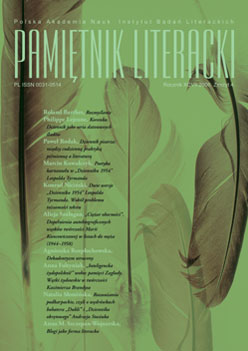Koronka. Dziennik jako seria datowanych śladów.
Tracery. A Diary as a Series of Dated Traces.
Author(s): Philippe LejeuneSubject(s): Literary Texts
Published by: Instytut Badań Literackich Polskiej Akademii Nauk
Keywords: personal diary; P.-H. Azaïs; C. Mauriac
Summary/Abstract: Translated from the French by and footnoted by Magda and Paweł Rodak. Philippe Lejeune’s paper is an analysis of a personal diary with regard to the categories of continuity and discontinuity. Initially, Lejeune considers not only two typical diary mediums: a notebook, which gives continuity to the subsequent notes, and loose pieces of paper, which – conversely – are a material sign of a diary’s discontinuity, but also exceptional cases of continuity and discontinuity of notebook series or agenda notes. Then Lejeune points at the necessity of examination of a diary’s rhythm, which is the frequency of notes additions (together with their length) in reference to historical time. He suggests his own, short definition of a diary as “a series of dated traces”. In the following part of the paper Lejeune regards a diary as a kind of “activity” and not a “product”, and discusses the reasons and the significance of the breaks in diary writing, i.e. the discontinuity of notes additions. Finally, Lejeune presents two interesting diaries as regards time construction: by Pierre-Hyacinthe Azaïs (1766–1845) and Claude Mauriac (1914–1996). The former was writing his diary for 34 years in 366 different files and added the subsequent notes using the same date but a year before. The latter, after a few dozen of years of diary writing, started composing further volumes by contrasting his notes written in different periods. In this way, as distinct from Azaïs, Mauriac transgresses the chronological continuity of a typical diary.
Journal: Pamiętnik Literacki. Czasopismo kwartalne poświęcone historii i krytyce literatury polskiej
- Issue Year: 2006
- Issue No: 4
- Page Range: 17-27
- Page Count: 11
- Language: Polish

